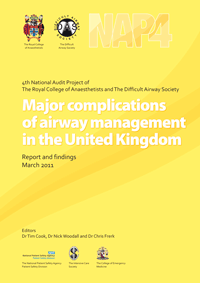
Continuing to look at the review of major airway complications from the UK.
–
Poor airway assessment contributed to poor airway outcomes. This was due to omission, incomplete assessment or a failure to alter the airway management technique in response to findings at assessment. Assessment to predict both potential airway difficulty and aspiration risk were equally important.[1]
How often do we even make an attempt at airway assessment in EMS?
Mallampati score?
Cormack-Lehane score?
These may not be directly applicable to the unconscious patient or the unstable patient, but we can get a quick idea of what we are dealing with.
In Part V I mentioned that one of our problems is that most of us just have a plan – It puts the tube in the hole.
We need a strategy.
A strategy requires assessment.
How difficult is this airway likely to be?
That is one of the parts of a strategy. Most of the strategic thinking begins long before we are near a patient, but assessment is an important bedside skill. Strategy is applying all of our preparation to the management of this patient’s airway, while still paying attention to the rest of what is going on with the patient.

Image credit.[2]
What about actually taking a peek in the patient’s mouth?
Is it wrong to use a laryngoscope to take a look at what is in the airway to help decide if intubation is appropriate for this patient?
No.
Whether this is an intubation attempt depends on the intent of the person with the laryngoscope – not on whether the laryngoscope passes the patient’s teeth/gums/lips. A simple rule is nice for the people who need simple rules, but airway management is not about simple rules. Airway management is about judgement.
More information, as long as it does not come at the expense of the patient, can be a very good thing.
Having an idea of what I am dealing with can help me decide how to go about managing this patient’s airway.
Maybe I can get the tube. Maybe, even with a very difficult tube, I can get it on the first shot. But is that what is best for the patient? Suppose I get the tube. Is the patient better with a tube?
What if the patient appears to have a bleed inside his/her brain. Maybe just BVM (Bag Valve Mask) ventilation is what will raise ICP (IntraCranial Pressure) the least. Probably without an oral or nasal airway. Even in the hospital, an LMA (Laryngeal Mask Airway) may be a quicker, less invasive way to prepare this patient for a CT scan.
Assessment is about much more than just placing the tube.
–
This was due to omission, incomplete assessment or a failure to alter the airway management technique in response to findings at assessment.[1]
Since we are not likely to change our approach to the management of this airway based on any assessment findings, why waste our time performing an assessment? Right?
–
Assessment to predict both potential airway difficulty and aspiration risk were equally important.[1]
Assessment for aspiration risk?
We don’t do that. We just use aspiration risk as an excuse when claiming that the patient needs an endotracheal tube, rather than an LMA.
Assessment to predict both potential airway difficulty and aspiration risk are equally ignored.
–
We make the bogus excuse that this does not apply to us.
We continue to kill patients.
–
See also:
What Does it Take to NOT Kill a Patient – Part I – 4/03/2011
What Does it Take to NOT Kill a Patient – Part II – 4/04/2011
What Does it Take to NOT Kill a Patient – Part III – 5/20/2011
What Does it Take to NOT Kill a Patient – Part IV – 5/23/2011
What Does it Take to NOT Kill a Patient – Part V – 5/30/2011
From EMCrit –
EMCrit Podcast 47 – Failure to Plan for Failure: A Discussion of Airway Disasters – 5/09/2011
From Resus.Me –
Anaesthesia’s dirty laundry – let’s all learn from it – 4/03/2011
–
Footnotes:
–
[1] Major complications of airway management in the UK – 2011 NAP4
Royal College of Anaesthetists
Executive Summary (page 1/3)
Page with link to various full text pdf versions of report, press release, executive summary, and full report.
–
[2] Rapid airway access
Sérgio L. AmantéaI; Jefferson P. PivaII; Malba Inajá RodriguesIII; Francisco BrunoIV; Pedro Celiny R. GarciaV
Print version ISSN 0021-7557
J. Pediatr. (Rio J.) vol.79 suppl.2 Porto Alegre Nov. 2003
doi: 10.1590/S0021-75572003000800002
Free Full Text Article from Jornal de Pediatria.
.

Subscribe to RogueMedic.com